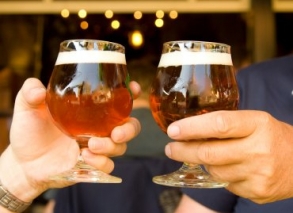Understanding Beer

- Wine this, wine that – Wine is good. Sometimes amazing. But people who only drink wine are lame. Broaden your horizons and explore the exciting world of beer.
- Beer lingo – “Beer goggles” and “frat water” can still be used in moderation, but if you’re going to get serious about beer you’ll want to familiarize yourself with some more technical terminology.
- Find some favorites – It’s more than just ales and lagers, though those are delicious. Try as many beers as you can (not all at once) and find a few go-to brews and types that you can count on.
- Beer and food pairing – Want to be a “foodie” with an edge? Drink craft beers with nice meals and spend less money than everyone else drinking wine at the table.
- Explore the world of beer – In many ways, beer is more accessible than wine, so take advantage of opportunities like beer festivals in your city, tastings at beer bars, and experimental home-brewing boondoggles.
Graduation marks many lifestyle changes in a twentysomething’s life. Expectations for civility are raised, wardrobes are re-jiggered, and use of the word “dude” may need to be budgeted more wisely
. These things, for better or for worse, are often essential elements of a recent grad’s transition into the “real world.” But one post-college myth that’s bandied about far too often is that as soon as you leave school, you have to stop drinking beers and start sipping wine. There’s a false belief that wine is the drink of “adults” and “nice dinners,” while beer is for the unsophisticated Joe Sixpacks of the world.
Well, I’m here to flip the script. Graduating college does not mean you have to throw away the beers. Maybe you should throw away the Keystone Lights and stop referring to them as “frat waters,” but it would be a shame to give up completely on such a varied and delicious genre of alcoholic beverage. Craft beers are more popular than ever, self-proclaimed “beer bars” are on the rise in almost every major city, and more restaurants are suggesting “beer pairings” with meals. In this guide, we’ll provide a brief primer on how to choose, find, and enjoy great beers. Move over chardonnay—the revolution starts (er, continues) here!
Beer-Drinking Basics
Firs things first: drinking beer should be fun, enjoyable, and unstressful. Never drink beers that you don’t like, unless there are no other beers available and you just want to get drunk. Some varieties are considered “trendy” and "refined" just like certain wines, but if you are ordering a Duvel just to look sophisticated, you may end up regretting the decision.
A true beer enthusiast will always be down to sample a new brew, even if it’s 8 o’clock in the morning. But it’s certainly worth developing an arsenal of “go-to” beers for casual sessions and enjoyment at home. Your best bet is to try a bunch of beers and see what you like. Here’s a very quick overview of some popular types of beers worth exploring, as well as some terminology that will help you ask after them at stores and bars.
Beer terms
Some lingo to help you navigate the beer bar.
- Hops. You’ll hear talk of “hops” and “hoppy” taste when you’re around beer drinkers. Hops come from hop plants (surprise!), and they are used as the primary flavoring agent in most beers. Hops add bitterness and act as a preservative.
- ABV. Alcohol by volume. This tells you how strong a beer is. Your average American lager (e.g., Miller) is about 4-5% ABV. “Ice” beers and malt beverages have higher alcohol content, and in general beers range from about 3-15% ABV.
- Craft. So-called “craft” beers are leading the charge in the quest to make people take beer seriously. These are brews made by independent, traditional brewers on a small scale (e.g., less than two million barrels a year). The antithesis of Budweiser.
- Microbrewery. Sometimes called a “craft” brewery, these small breweries usually produce less than 15,000 barrels per year. They generally produce a wider, more interesting variety than their larger counterparts. The biggest example of a craft brewery in the U.S. is Samuel Adams.
- Head. The foamy/creamy part at the top of the beer when your pour it. Most prevalent on stouts and bitters (think a pint of Guinness).
- Imperial pint. 20 fluid ounces, by the English measure. In the U.S., a pint is 16 oz. So if a bartender gives you the option of an imperial pint, you probably want to exercise it.
Types of beer
Ales and pale lagers are the most common families of beer. But there’s a vast world out there to explore. Here’s the tip of the iceberg.
- Lagers. Lagers are the most popular beers in the world, and probably what you’ve been drinking most of your college career (i.e., Bud, Miller, Coors, et al belong to the family of pale lagers). That said, the world of lagers is extremely varied, and each beer-drinking country has its own varieties. Light lagers are generally lower in alcohol and more carbonated than dark lagers, which get their richer flavor and color from roasted barley and hops. Another popular variety is the pilsner, another light-colored lager hailing from Europe—it is generally hoppier and more bitter than its American cousin. (Note: when people talk about rich folks who drink “imported beer,” they usually just mean European lagers like Stella Artois, Heineken, and Becks.) You might also run into German lagers of the “bock” family—you’ll notice they're maltier and higher in alcohol content. Lagers are usually stored and served at cold temperatures, and in general you can expect an ABV of about 4-5.5%. Where to Start: Too many to name—try to figure out if you like lighter, crisper lagers (e.g., Sam Adams, Stella) or a darker, richer incarnation (e.g., Saranac Nut Brown). Then mess with different countries and find a favorite.
- Ales. As with lagers, the diversity of ales is astounding. However, if you need some basic ways to differentiate: ales are less carbonated, lower in alcohol, and have a stronger taste of malty hops. There are bottled varieties, but ales are really best when cask-conditioned and served from the tap. “English Bitters” are the kings of ales, especially when served at room temperature with a nice pie. Brown ales—most famously Newcastle Brown Ale—are also popular, and they’re generally distinguished by their reddish-brown coloration and a sweeter taste of fruitiness or nuttiness. Darker “porters” are heavier and have a complex, chocolaty flavor. Finally, pale ales are—you guessed it—paler in color and very hoppy. Where to start: London Pride, Old Speckled Hen, Samuel Smith’s Taddy Porter, Harpoon IPA.
- Stouts. Technically, stouts are a sub-category of ales, but I think they’re worth mentioning in their own right, mostly because a lovely drop of Guinness is always a great fallback. Stouts are dark, often with a creamy head and taste of roasted barley (think chocolate and coffee undertones). Oatmeal, chocolate, and oyster stouts are also interesting options. Where to Start: Guinness, Beamish, Samuel Smith Oatmeal Stout.
- Hefeweizen. The hefeweizen, hailing from Germany, is the most popular variety of wheat beers. They are highly carbonated and generally have a cloudy appearance when poured. The wheat provides a crisp, refreshing taste that makes these beers popular in summertime. (You’ll often see them served in fruit varieties or with a lemon/orange segment.) American wheat beers can often be distinguished from their German predecessors by a hoppier flavor. Where to start: Paulander, Harpoon UFO, Erdinger, Rogue.
- Malt Beverages. I’m talking about malt liquor, son—not good or good for you, but fun to drink out of 40oz. bottles in brown paper bags. If you’re going to be “college,” at least go all out. Buy malt liquor instead of a 30-pack of Busch Light. Where to Start: Mickey’s, Olde English, Steel Reserve.
- Belgian/French/Trappist. Expect far higher alcohol content, stronger tastes, and funny glasses. Generally, these are considered “sipping” beers, so you won't find them in Irish pub or late-night hotspot (watch this idiot try to drink 10 in an hour). True “trappist” ales are rare because they literally brewed by or under the control of Trappist monks. Only seven of the 171 Trappist monasteries produce beer, the most of famous of which are Chimay and Orval. The different strengths are generally labeled Enkel (“single”), Dubbel (“double”), and Tripel (“triple”). Belgian blonde ales, being lighter and more akin to a hefeweizen, are a good introduction to the often intimidating world of Belgian and French beers. Where to Start: Leffe, Blue Moon, Chimay Rouge, Duvel Golden Ale.
Beer and Food Pairings
You know that Budweiser goes with hot dogs, cheddar cheese works well with a lovely pint of English ale, and a spicy Indian curry washes down nicely with a Cobra. But these days, beer pairings are becoming more and more sophisticated, to the point that many trendy restaurants treat them with the same snobbery as they would a wine menu. Don’t let that intimidate you, though. For the most part, a few basic rules of thumb will help you steer clear of any unwise combinations.
- Wine and beer aren’t so different. If you know the wine basics (e.g., white wine with lighter foods like chicken, fish, and pasta; red wine with heavier dishes like steak and stews), then you can pretty much just match the colors and pursue a similar plan of action. So if you’re having a piece of fish or salad, for example, look toward a lighter colored lager. If you’re having a shepherd’s pie or lamb chops, a darker ale or porter will compliment nicely. With a chocolaty desert, choose a chocolate stout. There are some nice ways to contrast your beer and food, but complimentary flavors are often a lot easier to pick out.
- Stay regional. Unlike wine, beer is produced in most parts of the world. Thus, it makes sense that beers from different countries/region would match up well with their foods. Tiger with South East Asian cuisine. Kirin with sushi. A German lager or pilsner with bratwurst and onions. That’s what’s up.
- Take risks later in the evening. Mealtime is not the best time to try something you’ve never had, like a high-alcohol Chimay or barley wine, or a fruity lambic. A strong or very sour beer could overwhelm the food and may be best enjoyed on its own terms.
Fun with Beer
Exploring the world of beer is fun and, dare I say it, a bit more accessible than diving headfirst into wine culture. Best of all, it’s pretty easy to do in most cities and you don’t have to drop an absurd amount of money to titillate the tastebuds and get a healthy, responsible buzz on. Here are some ideas.
- Find local “beer bars.” A beer bar sets itself apart by having a large, or at least distinguished, lineup of microbrews/craft/international beers on tap. Usually, the vibe is laidback—neither stuffy like a wine bar nor boisterous like a regular pub. They’ll often have some mainstays, with a year-round schedule of featured beers. Check out local newspapers and magazines (e.g., TimeOut) to track down beers bars in your area, or search for incomplete lists on PubCrawler.com. Beer bars are great places to begin tasting different beers, and they’ll often host special beer-related events and tastings.
- Cook with beer. Beer can chicken (also known as "beer in the butt chicken") is a real crowd-pleaser, but there are many more ways to experiment with beer in the kitchen (it’s great for marinades and stews, for one thing). Check out some recipes here.
- Visit a brewery. Visiting a vineyard can be time-consuming and costly—even if you don’t go to France or Napa Valley, you usually have to get out to some rural area where you clearly don’t live. Breweries and microbreweries, on the other hand, are often right smack in the city. Midwestern cities are especially good for brewery visits, but it’s worth looking into local options for a fun weekend activity. Find breweries here, then call up to see if they are open to the public—usually they’ll offer a tour and tastings. Some even have restaurants.
- Eat at a brewpub. Again, brewpubs won’t break the bank like a fancy meal with a $70 bottle of vino, but they are great fun. You can try some unique beers brewed on the premise and eat nachos—doesn’t get much better than that! There are some chains (e.g., Rock Bottom, John Harvard’s) and many local options. Find brewpubs here.
- Buy new beers to drink at home. Maybe the 7-11 doesn’t have a vast variety, but check out your local gourmet grocer or liquor store for a wider selection. Upscale supermarkets like Whole Foods and Harris Teeter also tend to offer a nice selection. Maybe you can even convince your grandma to get you a Beer of the Month membership for a graduation gift.
- Try home-brewing. Take it back to the days of moonshine by knocking up your own signature brew. Check out John Palmer’s “How to Brew” guide, and remember that it’s illegal to sell your concoction.
- Explore Beer Advocate. A great website for beer enthusiasts.
So there you have it—a brief survival guide to the world of (good) beer. Now let’s pour ourselves a delicious pint and watch a Good Eats special on beer and beer-making. L’chaim!
PS Be sure to check out our guide to Understanding Wine and Spirits, as well. It’s not that I don’t like other drinks—I’m just saying don’t discount beer!






Comments
(0)POST YOUR COMMENT